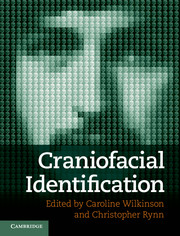Book contents
- Frontmatter
- Contents
- Contributors
- Part I Identification of the Living
- Chapter 1 Familiar face recognition
- Chapter 2 Unfamiliar face recognition
- Chapter 3 EFIT-V
- Chapter 4 Facial recall and computer composites
- Chapter 5 Facial ageing
- Chapter 6 Age progression and regression
- Chapter 7 Computer-assisted age progression
- Chapter 8 Facial recognition from identification parades
- Chapter 9 Virtual human identification line-ups
- Chapter 10 Computer-generated face models
- Chapter 11 Recognising and learning faces in motion
- Chapter 12 Facial image comparison
- Chapter 13 Three-dimensional facial imaging
- Part II Identification of the Dead
- Index
- Plate Section
- References
Chapter 13 - Three-dimensional facial imaging
Published online by Cambridge University Press: 05 May 2012
- Frontmatter
- Contents
- Contributors
- Part I Identification of the Living
- Chapter 1 Familiar face recognition
- Chapter 2 Unfamiliar face recognition
- Chapter 3 EFIT-V
- Chapter 4 Facial recall and computer composites
- Chapter 5 Facial ageing
- Chapter 6 Age progression and regression
- Chapter 7 Computer-assisted age progression
- Chapter 8 Facial recognition from identification parades
- Chapter 9 Virtual human identification line-ups
- Chapter 10 Computer-generated face models
- Chapter 11 Recognising and learning faces in motion
- Chapter 12 Facial image comparison
- Chapter 13 Three-dimensional facial imaging
- Part II Identification of the Dead
- Index
- Plate Section
- References
Summary
Introduction
There are many disciplines that are interested in characterising and measuring facial features and facial attractiveness. Several methods have been suggested to quantify facial shape and beauty, such as applying mathematical and geometric principles to facial morphology, for example, the golden proportion (1.618 and its reciprocal 0.618), Fibonacci series, averageness and symmetry (Ricketts, 1982; Rhodes, 2006). However, there is currently very little scientific evidence available to support the validity of these techniques. Overall facial attractiveness does not appear to depend on any single facial feature, although smiling and youthful facial appearance makes women look more attractive and facial attractiveness tends to decrease over time from ages 11 to 31 years. However, individuals tend to retain their relative levels of facial attractiveness throughout their lifespans (Tatarunaite et al., 2005).
Subtle facial differences make individual faces unique. However, we are able to distinguish between individuals of different gender, age, ethnicity and race (Moss et al., 1987; Kau et al., 2006; Toma et al., 2008; Richmond et al., 2009). Facial recognition has been of prime interest in computer vision not only for security reasons but also identification of medical conditions (Zhao et al., 2003). Recent studies have used static biometric methods to discriminate between normal and syndromic faces to a high level of sensitivity and specificity (e.g. Noonan syndrome) and to explore phenotype and genotype associations (Hammond et al., 2005a, 2005b). Dynamic facial acquisition is a relatively new development and the relative speed of facial movement has been used to identify depression (Mergl et al., 2005) and schizophrenia (Juckel et al., 2008). There are a number of medical conditions that have been reported to have a significant influence on face shape, e.g. asthma (Mattar et al., 2004) and Type I diabetes (El-Bialy et al., 2000). Socioeconomic factors are associated with higher body mass index (Ellaway et al., 1997), which in turn is related to both skeletal (Öhrn et al., 2002; Sadeghianrizi et al., 2005) as well as soft tissue facial shape (Ferrario et al., 2004) and severity of malocclusion in adolescents (Frazao and Narvai, 2006). The growth of the craniofacial skeleton is closely related to the masticatory muscle complex with stronger biting forces associated with a smaller face height and weaker forces associated with long faces with varying thickness in the masseter muscle mass (Varrela, 1991; Varrela and Alanen, 1995; Charalampidou et al., 2008). Sustained musical pursuits, such as violin/viola (Kovero et al., 1997) and wind instrument playing, as well as opera singing (Brattström et al., 1991), were found to have a significant effect resulting in a reduced face height. Facial width to height ratio has been reported as a predictor of aggressive behaviour (Carré and McCormick, 2008) and reduced facial expression has been associated with antisocial behaviour (Herpertz et al., 2001).
- Type
- Chapter
- Information
- Craniofacial Identification , pp. 154 - 165Publisher: Cambridge University PressPrint publication year: 2012
References
- 1
- Cited by



